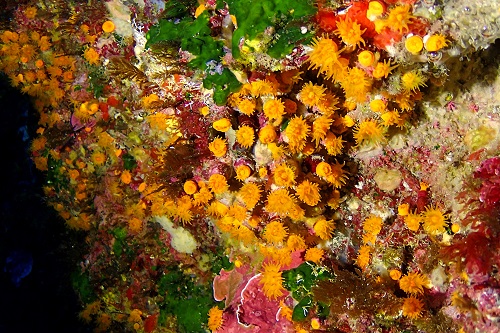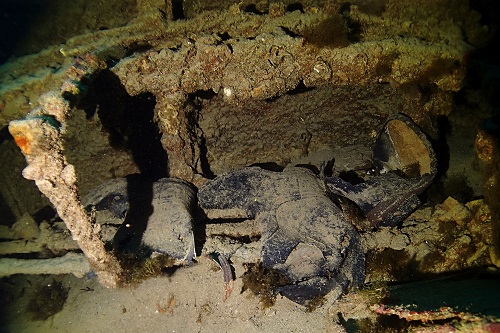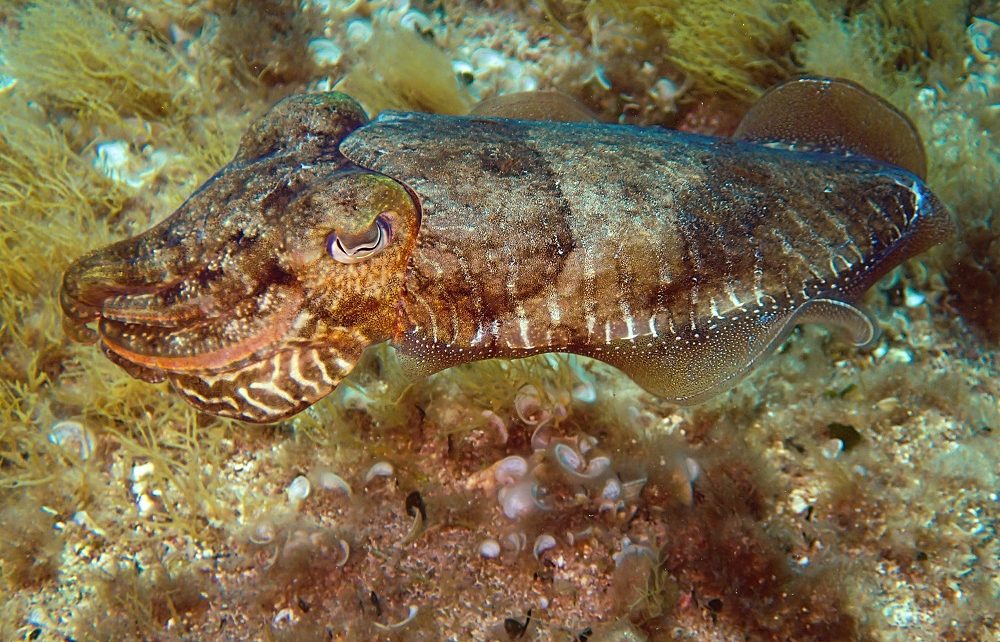The limestone shimmered gold in the blazing sun, reflected by the mirrored surface of the water below. Beneath the waves was a different world: vertical walls encrusted with hard corals and clusters of yellow anemones like fields of tentacled flowers. Bearded fireworms wove their way to their next meal and passing schools of bream glittered in the sunlight. Having heard 'The Med is dead', we were pleasantly surprised by the diving in Malta and Gozo.
Scenic Diving In Malta And Gozo
The Dwejra area on the west coast of Gozo offers the best scenic diving in the region. The huge limestone cliffs and the saltwater lagoon known as the Inland Sea attract topside visitors but there is far more beneath the surface.
Quickly finning across the Inland Sea, over hundreds of minuscule nudibranchs, we swam into a large crack in the cliff face. Following a tunnel through the rock, we heard propellers whirring as tiny tour boats motored overhead. At just 3 metres deep, we were skimming the bottom just trying to keep out of their way. Like moths we glided towards the light ahead, passing anemones and grey sponges as we gradually descended to 25 metres.

Yellow Anemones
Leaving the tunnel, we found ourselves in the open sea. The wall stretched as far as we could see and the bottom was a murky grey blur a long way below. We scoured the wall where we came across the highlight of our dive, a red-black triplefin. This little blenny had a typically gormless smile and was covered in striking blue spots.
Wreck Diving In Gozo
On the other side of Gozo, we dived the MV Karwela, a former ferry and one of several wrecks scuttled off the island's coast. Dropping down, we saw the entire ship sitting upright on the sand, clearly a relative of the boat that still ferries passengers back and forth between Malta and Gozo today. Hovering over the passenger deck, it was easy to imagine tourists thronging for views of the Gozitan coastline.

MV Karwela
Inside, the seats had been removed so there was plenty of room to glide along the now silent corridors and into various cabins on our way to the main stairwell. The staircase is one of the highlights of diving the Karwela. The way other divers described it, we were expecting a scene from Titanic with polished oak banisters gently illuminated by a crystal chandelier. The iron-railed reality however, was definitely more Gozo Ferries than White Star Line.
The Karwela wasn't devoid of life either. We saw shoals of damselfish and the odd wrasse cruising around on the wreck and spent our safety stop in the company of a rather large scorpionfish.
Diving 'Real' Wrecks In Malta
The most dived wrecks around Malta and Gozo have been deliberately scuttled to give tourists something to look at underwater. They all involve a long swim from the shore. For safety reasons they were also gutted before they were sunk. We preferred the few 'real' wrecks that unintentionally ended up at the bottom of the sea.

Octopus On The Maori
On Malta, our favourite of these wrecks was the Maori. After being bombed, the Maori split in two as it was being towed clear of the Grand Harbour. The stern was abandoned in deep water so only the bow is diveable. Being one of the few wrecks in Malta that was not scuttled for divers, the Maori stands out because many artefacts are still on board.
Cruising along the length of this skeletal wreck, we dropped down into the hold beneath. As our eyes adjusted to the gloom, which was punctuated here and there by shafts of light, we spotted a row of boots. These sat next to the tattered remnants of carefully folded WWII uniforms. On our way out of the hold, we found a brass shell casing half buried in the sand, the year '1941' still visible on the base.

Boots On The Maori
We found flabellina nudibranchs on the Maori and narrowly missed a weeverfish buried in the sand. We swam through shoals of damselfish and bream and watched flounders skittering across the seabed. There was even an octopus that eyed us suspiciously from its well-hidden hole.
Marine Life In Malta And Gozo
Although the Mediterranean Sea is not known for its marine life, looking carefully yielded some good finds. It also led to our dive guide mocking us for 'bimbling'. We found scorpionfish on the wrecks and reefs, camouflaged and sitting perfectly still. On many dives we came across a nudibranch or moray eel. On Malta, we saw octopus and cuttlefish and while there weren't so many crustaceans a decorator crab did make an appearance.

Nudibranch
There is no doubt that the chance to see good wrecks in warm, clear water is the main reason for diving in Malta. However, the marine life, while not exactly prolific, was also much better than we expected. We really enjoyed diving around Dwejra Bay in Gozo too. The underwater topography there became even more interesting in 2017 when the Azure Window, a huge limestone arch and symbol of Gozo, collapsed into the sea during a storm.
What To Know About Diving In Malta And Gozo
Most of the wrecks around Malta and Gozo were scuttled to provide points of interest for semi-submersible tours. For divers, this means all of the wrecks are just a little too far from the shore. We were led out to the wrecks at a depth of around 10 metres. By the time we reached the wrecks, we'd burned a lot of air and didn't have much time to explore. Bear this in and keep a careful eye on your air.

Scorpionfish
Tips For Diving In Malta And Gozo
There is good diving in Malta year round but June to September is best. The weather is more reliable and the water is warmer.
When diving the Inland Sea, take a torch with you. Although there is plenty of sunlight coming from both ends of the tunnel, you'll need a torch to find the life hiding in the darkest corners.
It is very common for thieves to steal from the dive vans while the divers are underwater. Leave your valuables at the dive centre before you depart.
There are small shops or stalls at most dive sites in Malta that generally serve sandwiches, ice creams and soft drinks. Bring a small amount of cash with you if you need to buy lunch.
